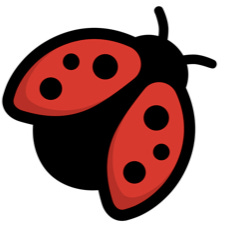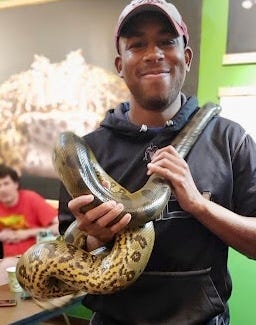My recent focus on writing about community science has opened many doors of knowledge. Community science, which is when the public helps with scientific research, can be done almost anywhere and is quite simple. In November 2022, I made the easy decision to try some projects after I read a series of stories about climate anxiety. I realized I was afflicted to some extent.
What can I do to help the Earth?
I’m no expert, can one person even make a difference?
Where is the best direction for me and my energy?
My gateway community science project was organized by the folks with Chattahoochee Riverkeeper (CRK), an Atlanta-based organization that focuses on ensuring we have clean waterways––CRK has a great reputation among environmentalists. When I read that they had scheduled a community science event called the Westside River Rendezvous, I knew I wanted to help. Volunteers would be asked to take water samples from metro Atlanta creeks and bring them back to CRK scientists for testing.
“This water sampling deal sounds great,” I told Fred, my husband. “Plus, and this part makes my heart so happy, it will be in person!” I was so jazzed up about getting to do the nature project with a bunch of other people, I signed us both up right away. We were overdue for human get-togethers after the recent years of virtual and Zoom life. River Rendezvous day arrived, and we loved it all: exploring the new Westside Beltline, feeling like serious scientists as we followed CRK’s rigorous protocols, chowing down on the free pizza with everyone else, and learning so much about our local watersheds. That day was when I first met Shaundon Moore, an employee of the West Atlanta Water Alliance (WAWA), who was helping to do the training at the CRK event. Moore spoke to our assembled group of some 90 people before we began our work.
“Today, we are testing the health of our streams. Remember, rainwater doesn’t just fall straight down into our waterways. If falls on everything out there,” Moore stretched his arms out wide. “Tires, trash, developers, industrial waste––all of it out there goes into the runoff that sheds down into our creeks.” Moore’s voice rang out louder than the others who’d spoken before him, getting our attention in a good way. The crows pecking for seeds over in the parking lot probably startled at his ringing words. Looking at him, you’d see Moore as just a regular young dude wearing a puffer and some old sneakers like most everyone else. His enthusiasm and his down-home explanations are what attracted attention. I wanted to know more about him. By the time we headed home, I had chatted with him a bit and had his full name and phone number saved in my phone.
His enthusiasm and down-home explanations are what attracted attention.
A few weeks later, he and I talked on Zoom. It was a workday, and I interviewed him while I sat inside my office and he sat, of course, at his outdoor picnic table office under some more swaying pine trees. He was at his workplace at WAWA’s Outdoor Activity Center in West Atlanta. Moore, 28, is the lead environmental educator at WAWA, a non-profit that seeks to improve the quality of life for residents in West Atlanta. Married and the father of two, Moore told me he has been fascinated by the natural world ever since he was a little kid even though no one in his house was especially nature oriented. “As the youngest of five kids, I was always different, all the time just wanting to be outside looking for lizards in the sun on the front porch. I got so good at catching them. No one in the family was a biologist or anything, but Mom was cool with it, she indulged me. She’d always show me the green garden snakes she found or let me keep a lizard in the house as a pet. I just like bugs and everything, really.”
At the end of high school, Moore, who grew up in Ellenwood, Ga., didn’t have to soul search at all when he was trying to decide what to study in college. It would be biology all the way. He attended Valdosta State University, which turned out to be a great fit for him as he earned good grades and enjoyed student life. Moore, who has a way of lifting his face and flashing a wide grin when something amuses him, strikes you as someone who relishes many things that come his way. One semester, he took classes with a biology professor who noticed his extreme enthusiasm for frogs. Telling me about it, Moore said with pride: “Yep, I turned into a Herp Head.” Herpetology is the study of amphibians.
Moore drew the attention of a few biology professors down in Valdosta and was eventually invited to work in the molecular ecology lab running tests and experiments. During this time, he even took some field trips with experts from Valdosta, studying amphibians in Colorado one summer, then later traveling to Kentucky to conduct field research on salamanders. “I loved it all,” he said, recalling the research trips. “Altogether, my Valdosta experiences put me on the master’s degree track.” During these years, he became a certified Master Herpetologist and decided to attend Central Michigan University where he graduated with a master’s degree in conservation biology. “I would have stayed there because I really liked the area a lot. Everyone there, even people I met in the community like waitresses and Uber drivers, were much more knowledge about conservation that I see here in Georgia. But the winters up north? No good.”
Back home in the metro Atlanta area, he worked for a while at the Georgia Aquarium, then later with Cobb County teaching about amphibians in nature outreach programs. When I told him how much we enjoyed listening to his authoritative statements during his talk at the River Rendezvous, he laughed. “That’s nice to hear. You never really know how you’re perceived. I guess it is true that wherever I work, I always seem to end up out front talking to people.” Now, he is embracing his role at WAWA where he is often a storyteller.
“I like the justice part of working here, sharing our story. You know, 20 years ago people living in these West Atlanta neighborhoods had dirty, sewage-filled streams. The city wasn’t paying attention. Locals had to organize and speak out about the damage untreated wastewater was doing to our creeks.” Now, Moore not only works with adults but often takes students from nearby schools on nature walks around WAWA’s 26-acre urban forest that includes an outdoor garden, a 1.5-mile trail and an event center. One class Moore especially enjoys teaching is called Boisterous Bugs.
As we finished our interview, we segued into the subject of bugs, then started talking about nature phobias. I told him how I was taking part in the Lost Ladybug Project, and introduced him to a nature phobia he’d never heard of, Coccinellidaephobia, a fear of ladybugs. I sent him a Reddit post I ran across that explained what Coccinellidaephobia is like:
“I’ve been afraid of them (ladybugs) my whole life and I don’t really have a reason. The way their wings pop out and just everything about them makes me sick to my stomach. . . My family and friends think it’s funny, but I have to beg someone to kill it until I start bawling. I killed one by myself today for the first time, but the crunch made my heart race. I won’t go for walks when it is nice out because I know they are flying around.”
Moore raised his eyebrows, reading the post with a faint smile. “Hadn’t heard of that one.” When asked about nature phobias, he said he didn’t think he had one. Since I’d already seen the photo of him with an Anaconda curled around his body, I had no reason for doubt. He added, “Scientifically, I think all fears are somewhat linked to our natural tendency as humans to protect ourselves. And, I do think that challenging our fears is an important and healthy thing to do.”
Before we ended our Zoom conversations, Moore told me again how much he liked the ideas behind The Everyday Scientist newsletter. “I really do love community science. Often you might see something out in the wild and others are like: really? They believe you, but yet, you know, they seem a tiny bit too incredulous. With community science we all get out there and do the seeing and hearing. Everyone can document––smartphones make it easy––and help tell the story. It’s fantastic!”
“Everyone can document––smartphones make it easy––and help tell the story.”
At home, Moore and his wife are raising two boys, ages 1 and 2. Even though they are so small, I’m going to go ahead with a prediction: Shaundon Moore’s kids will not have nature phobias. Those boys developing a nature phobia is as unlikely as Moore getting a garden snake mixed up with a pit viper––just not happening. I see his offspring becoming little magnifying-glass gripping Herp Heads just like their dear old dad.
The three upcoming community science projects on my radar screen are:
FrogWatch Training at the Sandy Creek Nature Center, Athens, Ga./Feb. 4
Marine Debris Tracker
Audubon Backyard Bird Count/Feb. 18, 19









He has always been interested in lizards and nature at a very very young age. This interview definitely captured the essence of Shaundon. Love you son!
Your interview makes me want to meet this guy! so interesting that he ended up at CMU (Audrey's and Jerry's Alma Mater)